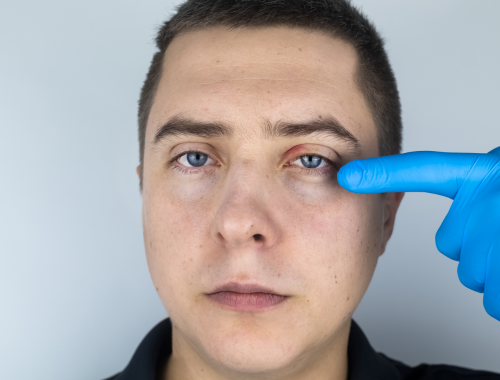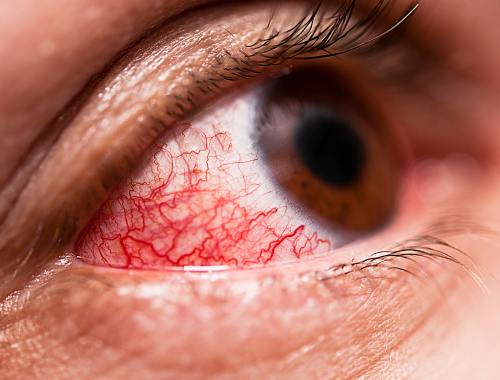Difference Between Blepharitis and Conjunctivitis
Blepharitis is the infection and inflammation of the eyelids whereas conjunctivitis is the bacterial, viral or allergic infection of the conjunctiva.
Similarity
Both share many common symptoms like teary eyes, dry eyes, irritation, sensitivity to light etc.

Blepharitis
Blepharitis is triggered by the blocking and clogging of the oil producing glands in your eyelids. In this condition, the eyelids become inflamed, irritated, red and there is itchiness and crust like scales that sit on the eyelashes. It is a treatable condition

Conjunctivitis
Conjunctivitis, also termed as ‘sticky eye’ or ‘pink eye’ is a condition which involves swelling of the conjunctiva (inner eyelids lining and the white portion of the eyes) If you have conjunctivitis due to viral infection, bacterial infection, allergic infection, UV burn and chemical irritation.
Difference between Blepharitis and Conjunctivitis
Definition
Blepharitis
It is the inflammation/swelling of the eyelids.
Conjunctivitis
It is the infection and swelling of the inner lining of the eyelids and the white portion and conjunctiva of the eyes.
Symptoms
Blepharitis
Watery eyes, dry eyes, itchiness, burning or stinging eyes, sensitivity to light, contact lens intolerance, eyelash rubbing against eyeball, crusts, or flakes around the eyelash roots, loss of eyelashes.
Conjunctivitis
Itchiness, puffy eyes, photophobia, watery eyes, increased tear production, gritty sensation in the eyes, sneezing, redness, irritation, sticky eyes, milky pus like discharge
Causes
Blepharitis
- Seborrhoeic dermatitis – dandruff of the scalp that progresses to eyelashes and eyelids
- Excess bacterial growth on the skin
- In some cases, the cause if excessive population of microscopic mites, termed as Demodex, residing inside the eyelash follicles.
- Allergic to skin make-up and eye make up
- Contact lens unsuitability
- Acne Rosacea and psoriasis
Conjunctivitis
- Bacterial (Streptococcus, Haemophilus, Staphylococcus, Moraxella species Corynebacterium, Pseudomonas, and) or viral infection termed as infective conjunctivitis
- Irritation, redness, and allergy in the eyes due to pollen and dust mites – this is termed as allergic conjunctivitis.
Treatment
Blepharitis
- Proper eyelid hygiene that includes warm compresses, warm water rinse, eyelid massage
- Eyelid scrubs
- Antibiotics
- Eyedrops to reduce swelling and redness
- Omega 3s fish oil – to make the oil glands work better
Conjunctivitis
- Viral conjunctivitis – use of anti-viral medication.
Eye-drop lubricants and cold compresses (a frozen or chilled material, such as an ice pack) can be used to relieve the symptoms.
- Bacterial conjunctivitis
- Clean with warm water
- Antibiotic eye drops or ointment to clear up the infection
- Oral antibiotics
Summary
The points of difference between Blepharitis and Conjunctivitis have been summarized as below:

FAQ:
How can you tell the difference between conjunctivitis and blepharitis?
Blepharitis is the infection and inflammation of the eyelids whereas conjunctivitis is the bacterial, viral or allergic infection of the conjunctiva.
Can blepharitis become conjunctivitis?
Yes, Blepharitis can result in recurrent spells of infected pink eye (conjunctivitis).
How do you treat blepharitis and conjunctivitis?
Blepharitis can be treated by warm compresses, rinsing eyelids with warm water, eyelid massage, and in some cases, doctors may even prescribe antibiotics.
Conjunctivitis can be treated by antibiotics, topically by using eye ointment/drops, and applying cold or warm compresses several times daily. For treating allergic conjunctivitis, medicines like antihistamines and mast cell stabilizers are used.
What triggers blepharitis?
Blepharitis triggers when there are excessive bacteria present in your eyelashes and in your eyelids.
What is the fastest way to cure blepharitis?
The fastest way to cure blepharitis include warm compresses, rinsing eyelids with warm water and, eyelid massage.
What is the first line treatment for blepharitis?
Eye-lid hygiene, comprising of eye-lid cleansing applying multiple a variety of measures, is the first line of management regardless of type of blepharitis.
Do you need antibiotics for blepharitis?
Usually, the condition goes away by cleaning the eyes, eyelids, and eyelashes properly multiple times a day. However, if blepharitis is severe, then topical antibiotic ointments (erythromycin or bacitracin) can be beneficial by application to the lid margin for two to eight weeks. Antibiotics taken through oral consumption that could help with relieving the symptoms of posterior blepharitis include oral tetracyclines and macrolide antibiotics.
What should you avoid if you have blepharitis?
Avoid sugary items, fried foods, processed foods, fizzy beverages, and white flour to aggravate the symptoms of this condition.
How do you clean your eyes with blepharitis?
Add some mild baby shampoo in warm water and a mild cleanser. Use a clean, soft cloth piece and dip it in this solution and rub your eyes, eye lids gently with this solution. This mixture will loosen crusts and prevent oil glands of eyes from clogging.
- Difference Between Global Warming and Greenhouse Effect - May 18, 2024
- Difference Between Vaccination and Immunization - March 3, 2024
- Difference Between Selective Mutism and Autism - February 25, 2024
Search DifferenceBetween.net :
Leave a Response
References :
[0]Alfonso, S. A., Fawley, J. D., & Lu, X. A. (2015). Conjunctivitis. Primary Care: Clinics in Office Practice, 42(3), 325-345.
[1]Bernardes, T. F., & Bonfioli, A. A. (2010, May). Blepharitis. In Seminars in ophthalmology (Vol. 25, No. 3, pp. 79-83). Taylor & Francis.
[2]Lindsley, K., Matsumura, S., Hatef, E., & Akpek, E. K. (2012). Interventions for chronic blepharitis. Cochrane database of systematic reviews, (5).
[3]Morrow, G. L., & Abbott, R. L. (1998). Conjunctivitis. American family physician, 57(4), 735.
